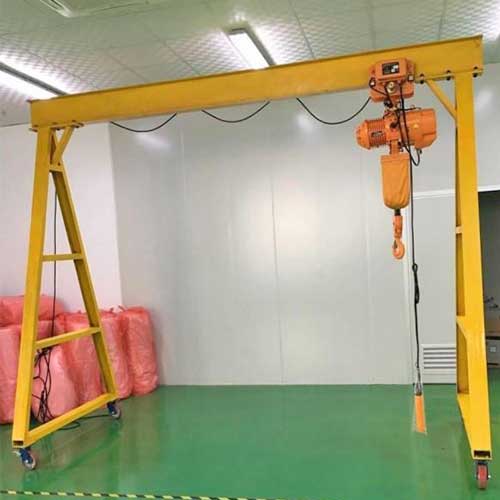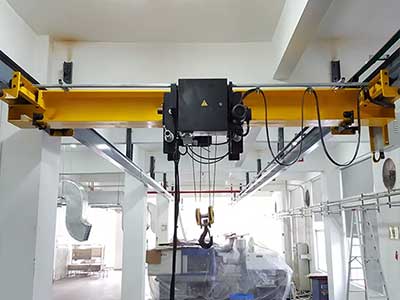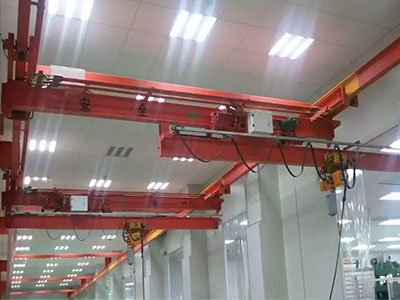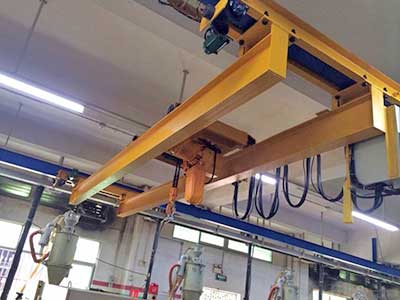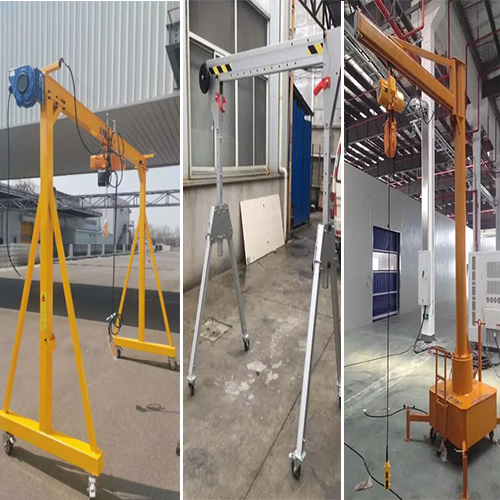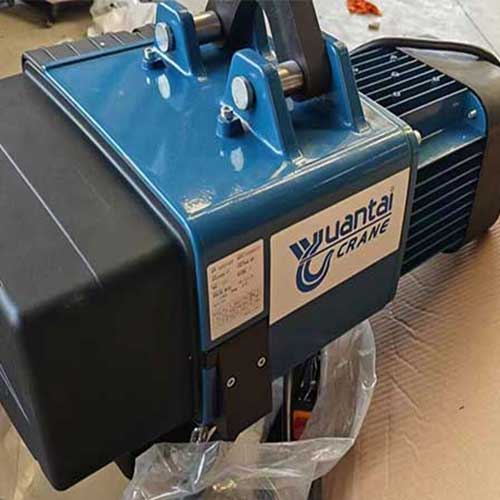Rolling Bridge Crane vs Rolling Gantry Crane vs Rolling Jib Crane
Overhead Rolling Crane for Sale. Rolling bridge crane/ Rolling gantry crane / Rolling jib crane, Select your Design.Custom rolling cranes good price.
Category: Overhead Crane on Wheels
Your Trusted Overhead Rolling Crane Manufacturer & Supplier
Rolling Bridge vs Rolling Gantry vs Rolling Jib Crane
Overhead Rolling Crane for Sale, Custom Overhead Rolling Cranes Good Price
In the industrial operations, the quest for efficiency and precision remains paramount. At the heart of many production facilities lies the indispensable overhead rolling crane—a powerful tool designed to streamline material handling tasks with ease and precision. As we embark on this journey to explore the realm of overhead rolling cranes, let's start by understanding their essence and the critical importance of selecting the right type for specific applications.
Overhead rolling cranes, also known as bridge cranes or overhead travelling cranes, are robust lifting devices mounted on an overhead runway structure. These cranes are characterized by their ability to traverse horizontally along the length of the runway, utilizing a bridge that spans the width of the workspace. Equipped with hoists and trolleys, overhead rolling cranes provide vertical lifting capabilities, enabling the efficient movement of heavy loads within industrial environments.
Importance of Selecting the Right Type Rolling Crane:
The significance of selecting the right type of overhead rolling crane cannot be overstated. Each type of crane—whether it's a rolling bridge, rolling gantry, or rolling jib crane—offers distinct features and capabilities tailored to specific applications. By choosing the most suitable crane design for a particular task or industry, businesses can optimize efficiency, enhance safety, and maximize productivity in their material handling operations. Therefore, understanding the nuances of each crane type is essential for making informed decisions and achieving optimal performance in industrial settings.
As we delve deeper into the world of overhead rolling cranes, let's explore the unique characteristics and applications of each type, empowering businesses to make educated choices that align with their operational needs and objectives. Join us on this journey as we unravel the complexities and possibilities of overhead rolling cranes, guiding you towards success in your material handling endeavors.
Overhead Rolling Cranes
Overhead rolling cranes stand as stalwarts in industrial settings, offering unparalleled efficiency and versatility in material handling tasks. Let's delve into the intricacies of these cranes, exploring their functionality, various designs, and the key components that differentiate them.
Overhead rolling cranes are formidable lifting machines designed to traverse horizontally along an elevated runway structure, known as a bridge or gantry, mounted on overhead rails. Their primary function is to lift and transport heavy loads with precision and efficiency within industrial environments. Equipped with hoists and trolleys, these cranes provide vertical lifting capabilities, enabling the movement of materials across vast workspaces with ease.
Explanation of the Rolling Bridge, Rolling Gantry, and Rolling Jib Crane Designs:

Rolling Bridge Crane:
The rolling bridge crane, also known as an overhead bridge crane, features a bridge that spans the width of the workspace and travels along parallel runways mounted on support structures.
This design offers exceptional versatility and coverage, allowing the crane to access various points within the workspace with ease.
Rolling bridge cranes are commonly used in manufacturing plants, warehouses, and assembly lines for lifting and moving heavy materials, machinery, and components.

Rolling Gantry Crane:
Rolling gantry cranes are similar to rolling bridge cranes but feature a single bridge supported by vertical legs or columns instead of parallel runways.
This design provides greater flexibility in terms of installation and space utilization, making it suitable for outdoor applications or facilities with limited headroom.
Rolling gantry cranes are commonly used in construction sites, shipyards, and storage yards for lifting and moving bulky materials and equipment.

Rolling Jib Crane:
Rolling jib cranes consist of a horizontal boom or arm that pivots around a vertical column mounted on a mobile or fixed base.
This design offers localized lifting capabilities, allowing the crane to reach areas where overhead clearance is limited or obstructed.
Rolling jib cranes are commonly used in workshops, maintenance facilities, and loading docks for precise material handling tasks, such as loading/unloading trucks or maneuvering heavy components.
Key Components and Structural Differences:
While all three types of overhead rolling cranes share the same fundamental principle of traversing along overhead runways, they differ in their structural configurations and key components:
Rolling Bridge Crane: Features parallel runways with a bridge spanning between them, supported by end trucks equipped with wheels or trolley systems.
Rolling Gantry Crane: Utilizes vertical legs or columns to support a single bridge, offering greater flexibility in terms of installation and space requirements.
Rolling Jib Crane: Consists of a horizontal boom or arm mounted on a vertical column, providing localized lifting capabilities with a pivoting motion.
These structural differences contribute to each crane type's unique capabilities and suitability for specific applications, allowing businesses to choose the most appropriate design to meet their material handling needs.
Rolling Gantry Crane
Rolling gantry cranes present a unique design tailored to specific industrial needs, offering versatility and efficiency in material handling tasks. Let's delve into the intricacies of rolling gantry cranes, exploring their design, functionality, comparative analysis with other crane types, as well as their advantages, disadvantages, and typical applications across various industries.
Overview of Rolling Gantry Crane Design and Functionality:
Rolling gantry cranes, also known as mobile gantry cranes, feature a single bridge supported by vertical legs or columns, equipped with wheels or castors for mobility. This design enables the crane to traverse horizontally along the ground, providing flexibility in terms of installation and space utilization. Rolling gantry cranes typically utilize hoists and trolleys for vertical lifting capabilities, allowing for efficient material handling within industrial environments.

Fixed Height Rolling Gantry Cranes:
Fixed height rolling gantry cranes are designed with a stationary vertical clearance, offering a consistent lifting height throughout their operation. These cranes are ideal for applications where the lifting requirements remain constant, and there is no need for vertical adjustment. Here's an overview of their key features and benefits:
- Stability: Fixed height gantry cranes provide stable lifting and movement operations, as the height remains consistent, minimizing the risk of load sway or instability during lifting.
- Simplicity: With a fixed height configuration, these cranes are straightforward to install and operate, requiring minimal setup and adjustment procedures.
- Cost-Effectiveness: Fixed height gantry cranes are cost-effective solutions for applications with consistent lifting requirements, offering efficient material handling capabilities at a lower initial investment compared to adjustable height cranes.
- Suitable Applications: These cranes are commonly used in manufacturing facilities, warehouses, and workshops for routine lifting tasks where the vertical clearance remains constant.

Adjustable Height Rolling Gantry Cranes:
Adjustable height rolling gantry cranes feature a versatile design that allows for vertical adjustment of the lifting height to accommodate varying workpiece sizes and lifting requirements. These cranes offer flexibility and adaptability, making them suitable for dynamic work environments. Here are some key features and benefits:
- Versatility: Adjustable height gantry cranes provide flexibility to lift and transport loads of different sizes and shapes by adjusting the lifting height as needed.
- Optimized Workspace Utilization: The ability to adjust the crane's height enables optimal utilization of vertical space within the workspace, allowing for efficient material storage and handling.
- Increased Reach: By adjusting the lifting height, these cranes can access hard-to-reach areas or accommodate taller workpieces, enhancing operational flexibility and productivity.
- Customizable Options: Adjustable height gantry cranes can be customized with various lifting attachments, automation features, and safety enhancements to meet specific application requirements.
- Adaptability: These cranes are suitable for a wide range of industries and applications, including manufacturing, construction, maintenance, and logistics, where lifting requirements may vary.

Lightweighted Aluminum Rolling Gantry Crane:
Lightweight aluminum rolling gantry cranes offer a portable and easily maneuverable solution for light-duty lifting tasks in diverse work environments. Constructed from aluminum, these cranes provide strength and durability while remaining lightweight for easy transportation and setup. Here are their key features and benefits:
- Portability: Aluminum gantry cranes are lightweight and portable, allowing for quick and easy relocation within the workspace or between job sites without the need for heavy lifting equipment.
- Corrosion Resistance: Aluminum construction provides excellent corrosion resistance, making these cranes suitable for outdoor use in environments with exposure to moisture or harsh weather conditions.
- Ease of Assembly: These cranes are designed for easy assembly and disassembly, with minimal tools and labor required for setup, saving time and effort during installation and transportation.
- Versatility: Lightweight aluminum gantry cranes are versatile solutions for light-duty lifting tasks in workshops, warehouses, and construction sites, offering flexibility to handle various materials and equipment.

Foldable Aluminum Rolling Gantry Crane:
Foldable aluminum rolling gantry cranes offer the added convenience of compact storage and transportation, making them ideal for applications where space is limited or mobility is required. These cranes feature a collapsible design that allows for easy folding and unfolding for storage or transport. Here's an overview of their key features and benefits:
- Space-Saving Design: Foldable gantry cranes can be easily folded into a compact size for storage or transportation, minimizing storage space requirements and facilitating transport between job sites.
- Quick Assembly: These cranes are designed for rapid assembly and disassembly, with foldable components that can be quickly unfolded and locked into place for use, reducing downtime and increasing operational efficiency.
- Mobility: The foldable design enhances the crane's mobility, allowing it to be transported in a compact form and deployed wherever lifting operations are required, even in confined or remote locations.
- Durability: Constructed from lightweight yet durable aluminum materials, foldable gantry cranes offer strength and reliability for light to moderate-duty lifting tasks in various industries and environments.
In summary, fixed height and adjustable height rolling gantry cranes provide versatile solutions for material handling tasks, with options available to suit specific lifting requirements, workspace constraints, and mobility needs. Lightweight aluminum and foldable gantry cranes offer additional benefits of portability, corrosion resistance, and space-saving design, making them suitable for a wide range of applications across different industries.
Comparison with Rolling Bridge and Rolling Jib Cranes:
Rolling Bridge Crane vs. Rolling Gantry Crane: Rolling bridge cranes traverse along elevated runways mounted on support structures, whereas rolling gantry cranes move along the ground on wheels or castors. While rolling bridge cranes offer superior vertical clearance and coverage, rolling gantry cranes excel in situations where overhead space is limited or inaccessible.
Rolling Jib Crane vs. Rolling Gantry Crane: Rolling jib cranes feature a horizontal boom or arm mounted on a vertical column, offering localized lifting capabilities with a pivoting motion. In contrast, rolling gantry cranes provide horizontal movement along the ground, making them suitable for applications requiring extensive coverage and flexibility in material handling.
Advantages and Disadvantages of Rolling Gantry Cranes:
Advantages:
Flexibility: Rolling gantry cranes offer flexibility in installation and space utilization, as they can be easily moved and positioned as needed within the workspace.
Accessibility: With their ground-level operation, rolling gantry cranes provide easy access to loads without the need for elevated runways or overhead clearance, making them suitable for facilities with limited headroom.
Versatility: Rolling gantry cranes can be used both indoors and outdoors, adapting to various work environments and applications with ease.
Cost-Effectiveness: Compared to fixed overhead cranes, rolling gantry cranes typically require lower installation costs and offer greater flexibility in terms of reconfiguration and relocation.
Disadvantages:
Lower Lifting Height: Rolling gantry cranes may have limitations in terms of lifting height compared to fixed overhead cranes, particularly in facilities with high ceilings.
Reduced Load Capacity: While rolling gantry cranes offer impressive load capacities, they may have limitations compared to larger fixed cranes due to their mobile design.
Mobility Constraints: In certain environments, the mobility of rolling gantry cranes may be hindered by obstacles or uneven surfaces, requiring additional precautions during operation.
Suitable Applications and Industries for Rolling Gantry Cranes:
Construction Sites: Rolling gantry cranes are commonly used in construction projects for lifting and moving materials and equipment across the job site.
Warehousing and Logistics: These cranes find applications in warehouses and distribution centers for loading and unloading goods, as well as organizing and transporting materials.
Outdoor Storage Yards: Rolling gantry cranes are ideal for outdoor storage yards and facilities where overhead clearance is limited, providing efficient material handling capabilities.
Shipbuilding and Repair: In shipyards and marine facilities, rolling gantry cranes are utilized for lifting and assembling ship components and performing maintenance and repair tasks.
In summary, rolling gantry cranes offer a versatile and cost-effective solution for material handling tasks in various industries and environments. With their flexibility, accessibility, and adaptability, these cranes provide efficient lifting capabilities, contributing to streamlined operations and enhanced productivity in industrial settings.
Rolling Jib Crane
Rolling jib cranes, also known as mobile jib cranes, offer a versatile and compact solution for material handling tasks in various industrial settings. Unlike traditional jib cranes that are fixed to a stationary support structure, rolling jib cranes feature a mobile design with wheels or castors, allowing for easy movement and positioning within the workspace. Let's delve deeper into the design, operation, unique features, benefits, considerations for selection, and specific applications of rolling jib cranes:

Rolling jib crane

Rolling cantilever jib hoist

Rolling portable jib crane
Rolling jib cranes consist of a horizontal boom or arm mounted on a vertical column or mast, similar to traditional jib cranes. However, what sets them apart is their mobile base, which allows for horizontal movement along the floor. The boom can rotate horizontally, providing coverage over a specific area within the workspace. The lifting mechanism, typically a hoist or chain block, is attached to the end of the boom, enabling vertical lifting of loads.
The operation of rolling jib cranes involves maneuvering the crane into position using the wheels or castors and then using the rotation mechanism to adjust the boom's angle and position as needed. This mobility and flexibility make rolling jib cranes suitable for lifting and positioning loads in confined spaces or areas where traditional overhead cranes cannot reach.
Unique Features and Benefits of Rolling Jib Cranes:
- Maneuverability: The mobile design of rolling jib cranes allows for easy movement and positioning within the workspace, providing flexibility to access different areas or workstations as needed.
- Compact Footprint: Rolling jib cranes have a small footprint, making them suitable for applications where space is limited or where traditional overhead cranes are impractical.
- Versatility: Rolling jib cranes can handle a variety of lifting tasks, including loading and unloading materials, assembly work, and machine maintenance, thanks to their adjustable boom and mobility.
- Cost-Effectiveness: Compared to larger overhead cranes, rolling jib cranes are typically more affordable to purchase and install, making them an economical choice for small to medium-sized businesses.
Considerations for Selecting Rolling Jib Cranes Over Other Types:
- Space Constraints: Rolling jib cranes are ideal for environments with limited overhead clearance or where floor space is restricted, as they do not require overhead support structures.
- Portability: If mobility and portability are essential factors for your lifting operations, rolling jib cranes offer the advantage of easy relocation within the workspace or between different job sites.
- Accessibility: Rolling jib cranes excel in applications where loads need to be lifted and positioned in tight or confined spaces, providing accessibility and maneuverability that may not be achievable with other types of cranes.
Specific Applications and Industries Where Rolling Jib Cranes Excel:
- Manufacturing: Rolling jib cranes are commonly used in manufacturing facilities for tasks such as assembly line operations, machine loading and unloading, and material handling within production cells.
- Warehousing and Logistics: In warehouses and distribution centers, rolling jib cranes are utilized for palletizing, order picking, and loading/unloading trucks in loading docks where overhead space is limited.
- Maintenance and Repair: Rolling jib cranes are valuable tools for maintenance and repair tasks in workshops, garages, and maintenance bays, allowing mechanics and technicians to lift and position heavy equipment or components with precision.
- Construction: On construction sites, rolling jib cranes can be used for lifting building materials, equipment, and tools to different levels of a structure or for maneuvering loads in congested work areas.
In summary, rolling jib cranes offer a compact, mobile, and versatile solution for lifting and material handling tasks in a wide range of industries and applications. Their unique design and operation make them well-suited for environments where space constraints, accessibility, and portability are important considerations. When selecting a crane for your specific needs, consider the advantages that rolling jib cranes offer over other types and their suitability for your particular application requirements.
Rolling Bridge Crane
Rolling bridge cranes, also known as overhead bridge cranes, are stalwarts in the realm of material handling, renowned for their robust design, exceptional versatility, and efficient operation. Let's delve into the intricacies of rolling bridge cranes, exploring their design, features, benefits, and common applications across various industries.
Description of Rolling Bridge Crane Design and Operation:
Rolling bridge cranes are characterized by their bridge structure that spans the width of the workspace, supported by end trucks equipped with wheels or trolley systems. These cranes traverse horizontally along parallel runways mounted on support structures, enabling them to access various points within the workspace with ease. Equipped with hoists and trolleys, rolling bridge cranes provide vertical lifting capabilities, allowing for the precise movement of heavy loads.
Single Girder Overhead Rolling Cranes:
Single girder overhead rolling cranes are a popular choice in industrial settings for their versatility, efficiency, and cost-effectiveness. These cranes feature a single girder beam that spans the width of the workspace, supported by end trucks equipped with wheels or trolley systems. Here's an overview of the key features and benefits of single girder overhead rolling cranes:
- Compact Design: Single girder cranes have a compact design, making them suitable for facilities with limited headroom or space constraints. The single girder design also reduces the overall weight of the crane, resulting in lower material and installation costs.
- Versatility: Despite their compact size, single girder cranes offer impressive lifting capacities and span lengths, allowing them to handle a wide range of loads and cover various work areas within the workspace.
- Efficient Operation: Equipped with electric or manual hoists and trolleys, single girder cranes provide efficient lifting and movement capabilities. The single girder design enables faster installation and commissioning compared to double girder cranes, minimizing downtime and disruptions to operations.
- Cost-Effectiveness: Single girder overhead rolling cranes are cost-effective solutions for material handling tasks, offering high performance at a lower initial investment compared to double girder cranes. They are suitable for light to moderate-duty lifting applications in industries such as manufacturing, warehousing, and logistics.

Single girder overhead rolling crane
Double Girder Overhead Rolling Cranes:
Double girder overhead rolling cranes are renowned for their robustness, stability, and ability to handle heavy loads with precision. These cranes feature two parallel girder beams supported by end trucks or trolleys, providing enhanced lifting capacities and greater span lengths compared to single girder cranes. Here are some key features and benefits of double girder overhead rolling cranes:
- High Lifting Capacity: Double girder cranes are capable of lifting heavier loads than single girder cranes, making them ideal for heavy-duty lifting applications in industries such as steel manufacturing, shipbuilding, and aerospace.
- Longer Span Lengths: With two girder beams spanning the width of the workspace, double girder cranes offer greater span lengths and coverage, allowing them to access hard-to-reach areas and handle larger workpieces with ease.
- Stability and Precision: The dual girder design provides increased stability and precision during lifting and movement operations, minimizing load sway and ensuring accurate positioning of heavy loads.
- Customization Options: Double girder overhead rolling cranes can be customized to meet specific application requirements, including the integration of specialized lifting attachments, automation systems, and safety features.
- Durability and Reliability: Built to withstand harsh industrial environments, double girder cranes are constructed from high-quality materials and components, ensuring long-term durability and reliability in demanding operating conditions.
In summary, while single girder overhead rolling cranes offer compactness, versatility, and cost-effectiveness for light to moderate-duty lifting applications, double girder cranes provide superior lifting capacities, span lengths, and stability, making them the preferred choice for heavy-duty industrial lifting tasks. The selection between single and double girder cranes depends on factors such as load requirements, workspace constraints, and budget considerations.

Double girder top running overhead rolling crane
Features and Benefits of Rolling Bridge Cranes:
- Exceptional Versatility: Rolling bridge cranes offer unparalleled versatility, thanks to their ability to traverse the entire length of the runway. This allows for efficient coverage of the workspace and easy access to multiple workstations or areas within a facility.
- High Load Capacity: Designed to handle heavy loads with ease, rolling bridge cranes boast impressive lifting capacities, making them suitable for lifting and moving bulky materials, machinery, and components.
- Precise Control: Equipped with advanced control systems, rolling bridge cranes provide precise control over load positioning, ensuring smooth and accurate lifting and movement operations.
- Space Optimization: By utilizing overhead space, rolling bridge cranes help optimize floor space utilization, allowing for efficient material handling without cluttering the workspace with floor-mounted equipment.
- Increased Productivity: With their ability to streamline material handling processes and reduce manual effort, rolling bridge cranes contribute to increased productivity and throughput in industrial operations.
Applications and Industries Where Rolling Bridge Cranes Are Commonly Used:
- Manufacturing Plants: Rolling bridge cranes are widely used in manufacturing facilities for lifting and moving heavy machinery, equipment, and materials during production processes.
- Warehouses and Distribution Centers: These cranes play a crucial role in warehouses and distribution centers for loading and unloading goods from trucks and containers, as well as for organizing and transporting materials within the facility.
- Assembly Lines: Rolling bridge cranes are integral to assembly lines, where they facilitate the movement of components and products between different stages of the assembly process.
- Metalworking and Fabrication Shops: In metalworking and fabrication shops, rolling bridge cranes are used for handling raw materials, workpieces, and finished products with precision and efficiency.
- Automotive Industry: Rolling bridge cranes find applications in automotive manufacturing plants and repair shops for lifting and transporting vehicles, engines, transmissions, and other heavy components.
In essence, rolling bridge cranes stand as versatile workhorses in industrial environments, offering unmatched efficiency, precision, and productivity gains. Their robust design, impressive load capacities, and wide-ranging applications make them indispensable assets across various industries, contributing to streamlined material handling operations and optimized workflow processes.
Comparison Classification Based on Capacity
Selecting the appropriate lifting capacity is crucial when choosing an overhead rolling crane to ensure efficient and safe material handling operations. Let's compare rolling bridge, rolling gantry, and rolling jib cranes based on their lifting capacities and provide guidelines for selecting the right crane capacity for specific lifting requirements.
Comparison of Lifting Capacity:
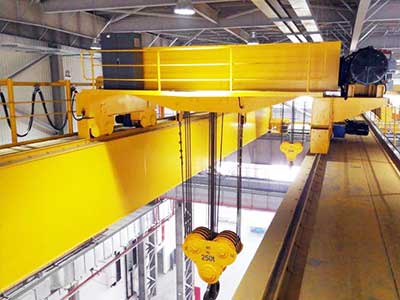
Rolling Bridge Crane:
Rolling bridge cranes typically offer a wide range of lifting capacities, ranging from a few hundred pounds to several tons.
These cranes are available in various configurations to accommodate different load requirements, making them suitable for both light and heavy lifting tasks.

Rolling Gantry Crane:
Rolling gantry cranes also come in a variety of lifting capacities, ranging from light-duty to heavy-duty applications.
The lifting capacity of rolling gantry cranes is influenced by factors such as the structural design, materials used, and size of the crane components.

Rolling Jib Crane:
Rolling jib cranes are typically designed for lighter lifting tasks compared to rolling bridge and rolling gantry cranes.
While they may have lower lifting capacities compared to other types of overhead rolling cranes, rolling jib cranes excel in providing localized lifting solutions for specific applications.
Guidelines for Selecting Crane Capacity:
- Assess Lifting Requirements: Determine the maximum weight of loads that the crane will need to lift on a regular basis. Consider both static and dynamic loads, as well as any potential future increases in lifting requirements.
- Consider Safety Margins: Factor in safety margins when selecting crane capacity to ensure the crane can safely handle loads without exceeding its rated capacity. It's essential to account for unexpected load variations and potential impacts on the crane's performance.
- Evaluate Workspace Limitations: Take into account any spatial constraints within the workspace, such as overhead clearance, aisle width, and floor space availability. Choose a crane with a lifting capacity that meets your requirements while considering the physical constraints of the environment.
- Consult Manufacturer Specifications: Refer to manufacturer specifications and guidelines to determine the appropriate crane capacity based on the intended application, structural design, and operational requirements.
- Seek Expert Advice: If uncertain about the appropriate crane capacity for your specific needs, consult with experienced crane professionals or engineers who can provide tailored recommendations based on their expertise and industry knowledge.
In conclusion, selecting the right crane capacity is essential for ensuring safe and efficient material handling operations. By comparing the lifting capacities of rolling bridge, rolling gantry, and rolling jib cranes and following guidelines for selecting crane capacity, businesses can make informed decisions that align with their lifting requirements and operational constraints.
Classification Based on Span and Reach
Span and reach capabilities are critical factors to consider when selecting an overhead rolling crane, as they determine the crane's coverage area and ability to access various points within the workspace. Let's examine rolling bridge, rolling gantry, and rolling jib cranes based on their span and reach capabilities and discuss considerations for choosing the crane with the suitable span and reach for specific workspace dimensions.
Examination of Span and Reach Capabilities:
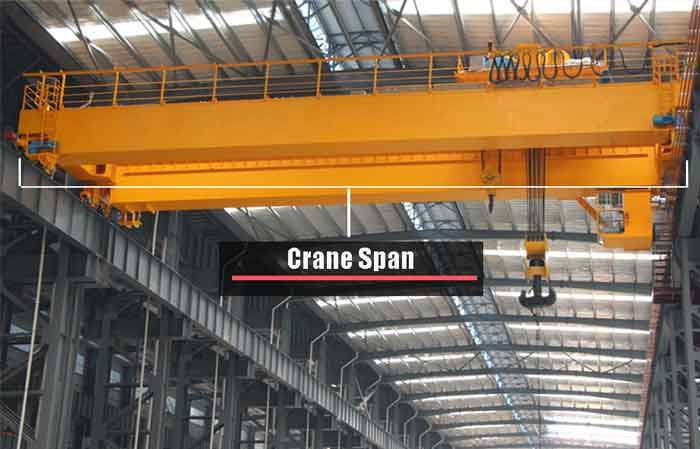
Rolling Bridge Crane :
Rolling bridge cranes typically offer a customizable span that can be tailored to the specific dimensions of the workspace.
The span of a rolling bridge crane refers to the distance between the runways or support structures on which the bridge travels.
The reach of a rolling bridge crane is determined by the length of the bridge, which can be extended or retracted to access different areas within the workspace.

Rolling Gantry Crane:
Rolling gantry cranes also provide customizable span and reach capabilities, depending on the structural design and configuration of the crane.
The span of a rolling gantry crane is determined by the distance between the vertical legs or columns that support the bridge.
The reach of a rolling gantry crane is influenced by the length of the bridge and the mobility of the gantry legs, allowing for flexibility in accessing various work areas.

Rolling Jib Crane:
Rolling jib cranes typically offer a limited span and reach compared to rolling bridge and rolling gantry cranes.
The span of a rolling jib crane is determined by the horizontal reach of the jib arm, which pivots around a vertical column or mast.
The reach of a rolling jib crane is defined by the length of the jib arm, which can vary depending on the specific crane model and design.
Considerations for Choosing Suitable Span and Reach:
- Workspace Dimensions: Evaluate the dimensions of the workspace, including length, width, and height, to determine the appropriate span and reach requirements for the crane.
- Access Points: Consider the location of access points, loading/unloading areas, and workstations within the workspace to ensure the crane can reach all necessary areas without obstruction.
- Load Handling Requirements: Assess the size and weight of loads that the crane will need to lift and transport, ensuring that the crane's span and reach capabilities align with the lifting requirements.
- Operational Efficiency: Choose a crane with span and reach capabilities that optimize operational efficiency and minimize downtime by providing adequate coverage and accessibility within the workspace.
- Future Expansion: Anticipate potential future changes or expansions in the workspace layout and requirements, selecting a crane with adaptable span and reach capabilities to accommodate evolving needs.
By carefully evaluating the span and reach capabilities of rolling bridge, rolling gantry, and rolling jib cranes and considering specific workspace dimensions and requirements, businesses can choose the crane configuration that best suits their material handling needs and operational constraints.
Classification Based on Mobility
The mobility of an overhead rolling crane is a crucial consideration, as it determines the crane's flexibility and adaptability to various work environments. Let's evaluate the mobility options for rolling bridge, rolling gantry, and rolling jib cranes, including fixed, semi-mobile, and mobile configurations, and discuss the factors influencing mobility requirements and considerations for selecting the most suitable option.
Fixed Configuration:
Fixed overhead rolling cranes are permanently installed in a specific location within the workspace.
These cranes are anchored to structural supports or overhead runways, providing stability and reliability for lifting operations.
Fixed cranes are ideal for applications where lifting requirements are consistent, and there is no need for crane mobility.
Semi-Mobile Configuration:
Semi-mobile overhead rolling cranes feature wheels or castors mounted on the crane components, allowing for limited mobility within a defined area.
These cranes can be relocated within the workspace or between different locations, providing flexibility to adapt to changing operational requirements.
Semi-mobile cranes are suitable for applications where occasional repositioning of the crane is necessary to access different work areas or accommodate varying production layouts.
Mobile Configuration:
Mobile overhead rolling cranes are fully portable and can be moved freely around the workspace or between different locations.
These cranes are mounted on wheeled frames or platforms, allowing for easy transportation and deployment wherever lifting operations are required.
Mobile cranes offer the highest level of flexibility and adaptability, making them ideal for dynamic work environments with shifting lifting requirements.
Factors Influencing Mobility Requirements:
- Workspace Layout: The layout of the workspace, including the presence of obstacles, narrow aisles, and spatial constraints, influences the mobility requirements for the crane.
- Operational Flexibility: Consider the need for the crane to access different work areas or adapt to changing production layouts, which may necessitate greater mobility capabilities.
- Frequency of Use: Determine how often the crane will need to be moved or repositioned within the workspace, as this will impact the feasibility of different mobility options.
- Installation and Setup: Assess the ease of installation and setup for different mobility configurations, considering factors such as installation time, equipment requirements, and labor costs.
Considerations for Selecting the Most Suitable Option:
- Operational Efficiency: Choose a mobility configuration that optimizes operational efficiency by providing the necessary level of mobility to meet lifting requirements while minimizing downtime and disruptions.
- Safety: Prioritize safety when selecting a mobility option, ensuring that the crane remains stable and secure during lifting operations and movement within the workspace.
- Cost-Effectiveness: Consider the cost implications of different mobility configurations, including initial investment costs, maintenance requirements, and potential productivity gains associated with enhanced mobility.
- Future Expansion: Anticipate future changes or expansions in the workspace layout and lifting requirements, selecting a mobility option that allows for scalability and adaptability to evolving needs.
By evaluating mobility options for overhead rolling cranes and considering factors such as workspace layout, operational flexibility, safety, cost-effectiveness, and future expansion plans, businesses can select the most suitable configuration to optimize material handling operations and enhance productivity.
Classification Based on Power Source
The power source of an overhead rolling crane plays a significant role in its performance, reliability, and operational efficiency. Let's analyze the power sources available for overhead rolling cranes, including electric, hydraulic, and manual operation, and discuss the advantages, disadvantages, and considerations for selecting the most suitable option.
Analysis of Power Sources:
Electric Operation:
Electric overhead rolling cranes are powered by electricity and utilize electric motors to drive the hoist, trolley, and bridge mechanisms.
These cranes are versatile and efficient, offering precise control over lifting and movement operations.
Electric cranes are commonly used in indoor applications where access to power sources is readily available, such as manufacturing plants, warehouses, and assembly lines.
Hydraulic Operation:
Hydraulic overhead rolling cranes use hydraulic power to operate the lifting and movement mechanisms, relying on hydraulic pumps, cylinders, and valves.
These cranes are known for their robustness and ability to handle heavy loads with ease.
Hydraulic cranes are often used in outdoor environments or applications where electricity is not readily available, such as construction sites, shipyards, and storage yards.
Manual Operation:
Manual overhead rolling cranes are operated manually by workers, utilizing hand-operated chain hoists or lever systems to lift and move loads.
These cranes are simple in design, cost-effective, and suitable for light-duty lifting tasks.
Manual cranes are commonly used in small workshops, maintenance facilities, and loading docks where occasional lifting operations are required.
Advantages and Disadvantages:
Electric Operation:
Advantages: Precise control, efficient operation, suitable for indoor applications, low maintenance requirements.
Disadvantages: Dependency on electricity supply, potential downtime due to electrical issues, higher initial investment costs compared to manual cranes.
Hydraulic Operation:
Advantages: Robust and durable, capable of handling heavy loads, suitable for outdoor applications, less susceptible to electrical failures.
Disadvantages: Limited precision compared to electric cranes, higher maintenance requirements, potential hydraulic fluid leaks.
Manual Operation:
Advantages: Simple and cost-effective, no dependency on power sources, suitable for intermittent lifting tasks.
Disadvantages: Limited lifting capacity, manual effort required for operation, slower lifting and movement speeds compared to powered cranes.
Considerations for Selection:
- Application Requirements: Evaluate the specific lifting requirements, operational environment, and frequency of use to determine the most suitable power source for the crane.
- Availability of Power: Consider the availability of electricity or hydraulic power sources in the workspace when selecting a powered crane, ensuring compatibility with existing infrastructure.
- Precision and Control: Determine the level of precision and control required for lifting and movement operations, opting for electric or hydraulic cranes for applications that demand precise positioning and control.
- Cost Considerations: Assess the initial investment costs, maintenance requirements, and long-term operating costs associated with each power source option, balancing performance with budget constraints.
- Environmental Factors: Consider environmental factors such as temperature extremes, moisture levels, and exposure to corrosive substances when selecting a power source for the crane, ensuring compatibility with the operational environment.
By carefully analyzing the advantages, disadvantages, and considerations for each power source option, businesses can select the most suitable overhead rolling crane configuration to optimize material handling operations and meet their specific lifting requirements.
In material handling, selecting the right overhead rolling crane is paramount to ensuring efficient, safe, and productive operations. As we conclude our exploration of rolling bridge, rolling gantry, and rolling jib cranes, let's recap the key differences between these crane types and offer guidance for overhead rolling crane buyers to make informed decisions tailored to their specific application requirements.
Summary of Key Differences:
Rolling Bridge Crane:
Characterized by a bridge that spans the width of the workspace, supported by end trucks traveling along parallel runways.
Offers exceptional versatility and coverage, making it ideal for applications requiring access to various points within the workspace.
Suitable for indoor environments such as manufacturing plants, warehouses, and assembly lines.
Rolling Gantry Crane:
Features a single bridge supported by vertical legs or columns, providing flexibility in installation and space utilization.
Offers portability and accessibility, making it suitable for both indoor and outdoor applications, including construction sites, shipyards, and storage yards.
Rolling Jib Crane:
Consists of a horizontal boom or arm mounted on a vertical column, offering localized lifting capabilities.
Ideal for applications requiring precise material handling in confined spaces, such as workshops, maintenance facilities, and loading docks.
Guidance for Overhead Rolling Crane Buyers:
- Assess Application Requirements: Determine the specific lifting requirements, operational environment, and spatial constraints to identify the most suitable crane type for the application.
- Consider Functionalities: Evaluate the functionalities and features offered by each crane type, such as lifting capacity, span and reach capabilities, mobility options, and power sources.
- Balance Performance and Cost: Balance performance requirements with budget constraints, considering factors such as initial investment costs, maintenance requirements, and long-term operating costs.
- Consult with Experts: Seek advice from crane professionals or engineers with expertise in overhead rolling crane systems to ensure informed decision-making and optimal crane selection.
- Plan for Future Needs: Anticipate potential future changes or expansions in operational requirements and workspace layout, selecting a crane type that offers scalability and adaptability to evolving needs.
By considering these key differences and guidance points, overhead rolling crane buyers can make informed decisions that align with their specific application requirements, maximizing efficiency, productivity, and safety in material handling operations. Whether it's a rolling bridge, rolling gantry, or rolling jib crane, choosing the right crane type is essential for success in the dynamic world of industrial operations.
Related Products

Latest project
150 Ton Overhead Crane Installation Feedback – Paraguay Case
QDX 150 ton overhead crane in action in Paraguay. Installation photos, video, and client feedback show performance, safety, and heavy-lifting efficiency.
Free consultation to Confirm Parameters & Specifications and Get
Latest Crane Price & Crane Rate.
- Types of overhead cranes : _______?
- Optional: Overhead travelling crane, goliath gantry crane,Slewing jib crane, Single girder or double girder crane,small portable crane or kbk crane, etc.
- Capacity of overhead crane: _______?
- Optional: 0.25ton, 0.5 ton, 1 ton, 2 ton, 3ton, 5 ton, 10 ton,15ton, 20ton, 25 ton, 30ton,35ton, up to 550ton, etc.
- Crane span & lifting height : _______?
- Crane travelling length : _____?
- Control of overhead crane:_______?
- Optional: pendant/ remote/cabin control
- Voltage supply of overhead crane:_____?
- Eg,: 380V50/60HZ,3Phase or others,etc.
- Application/usage of crane:_______?
- Eg,: Steel mill, ,injection mold, cement,stone, concrete,granite, general manufacturing, etc.
Just leave a message via the contact form and our hoist and crane engineer will contact you with in 24working hours.
Get In Touch
